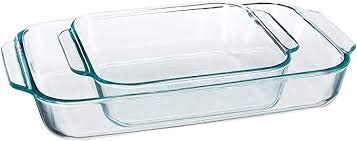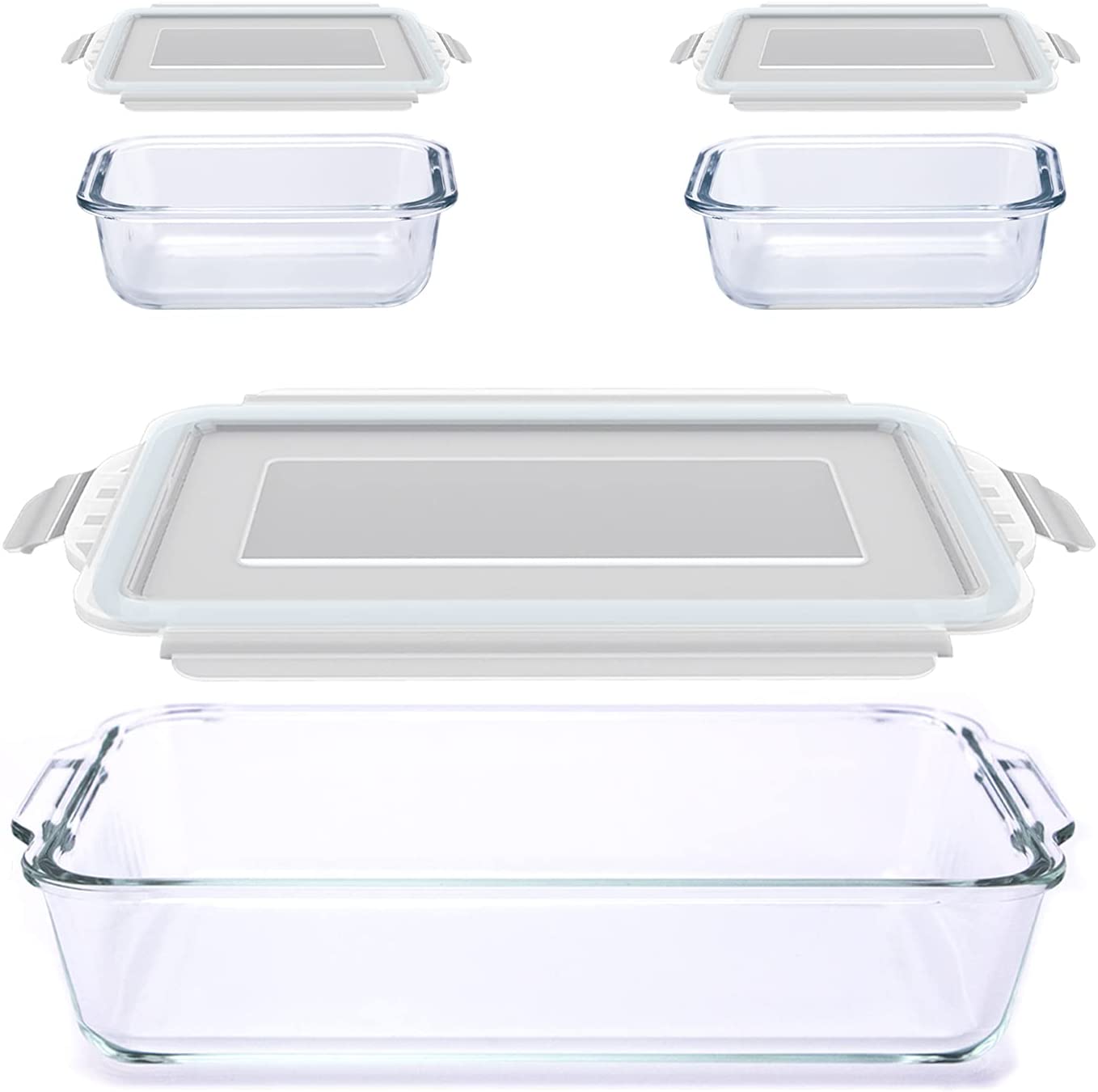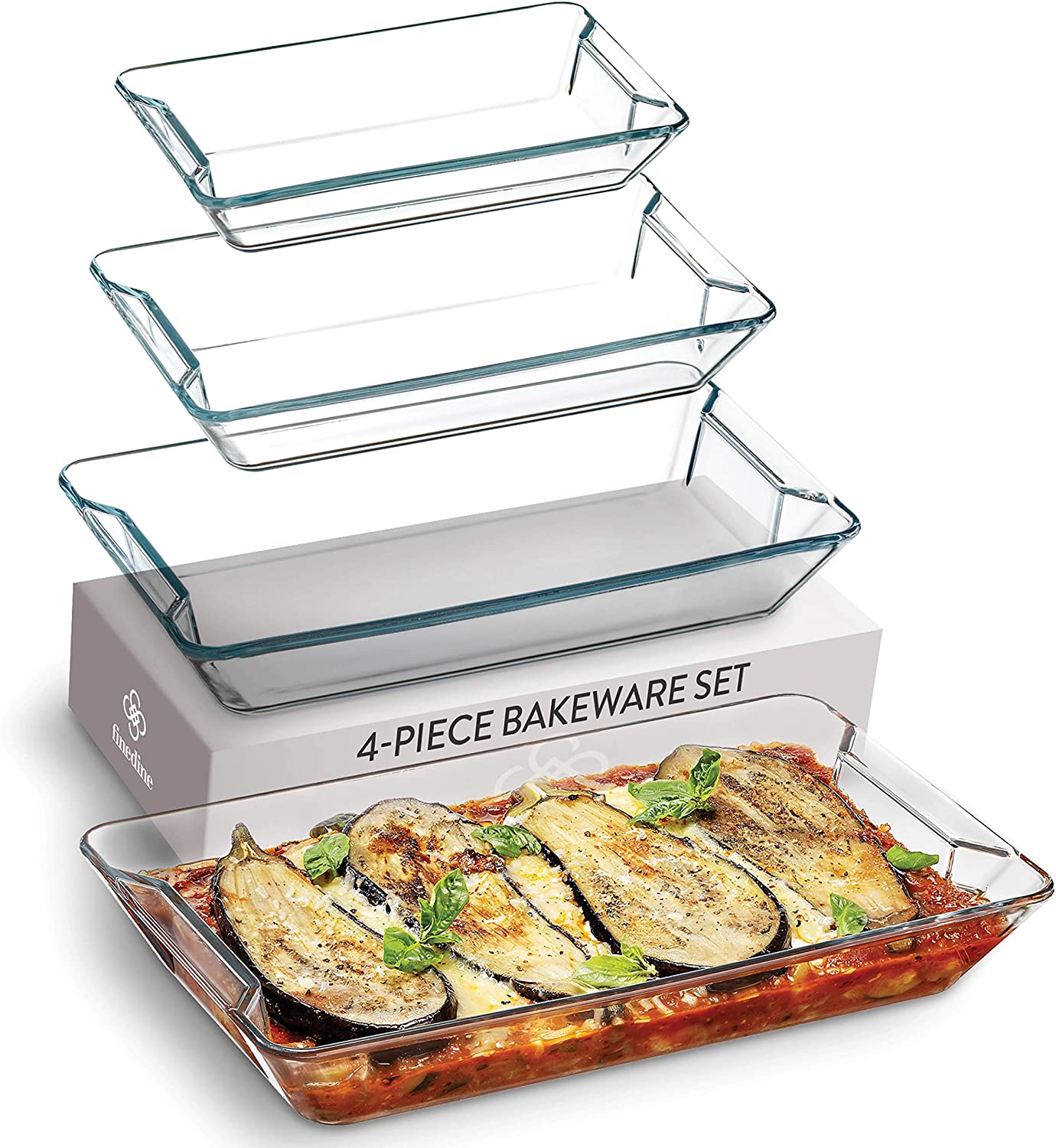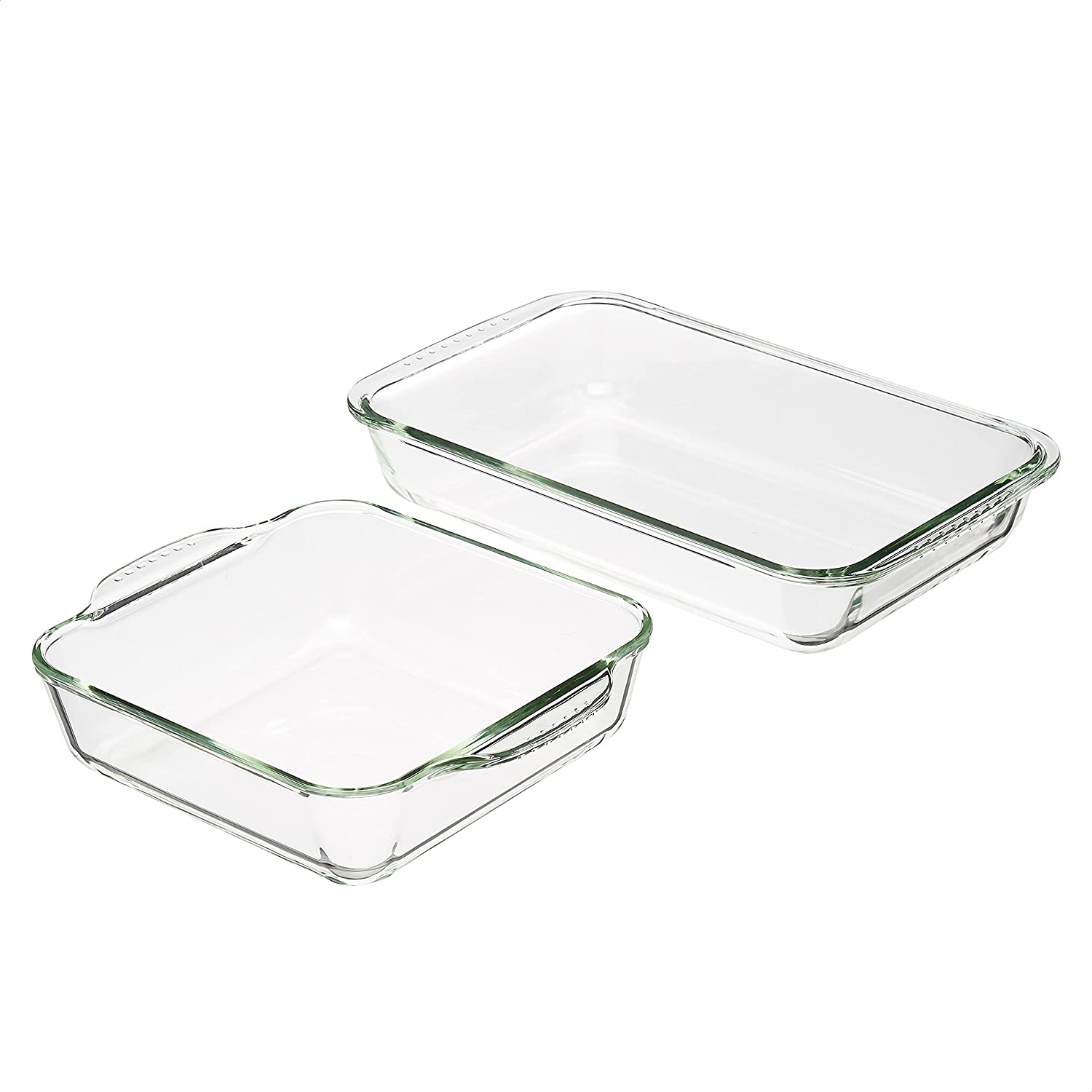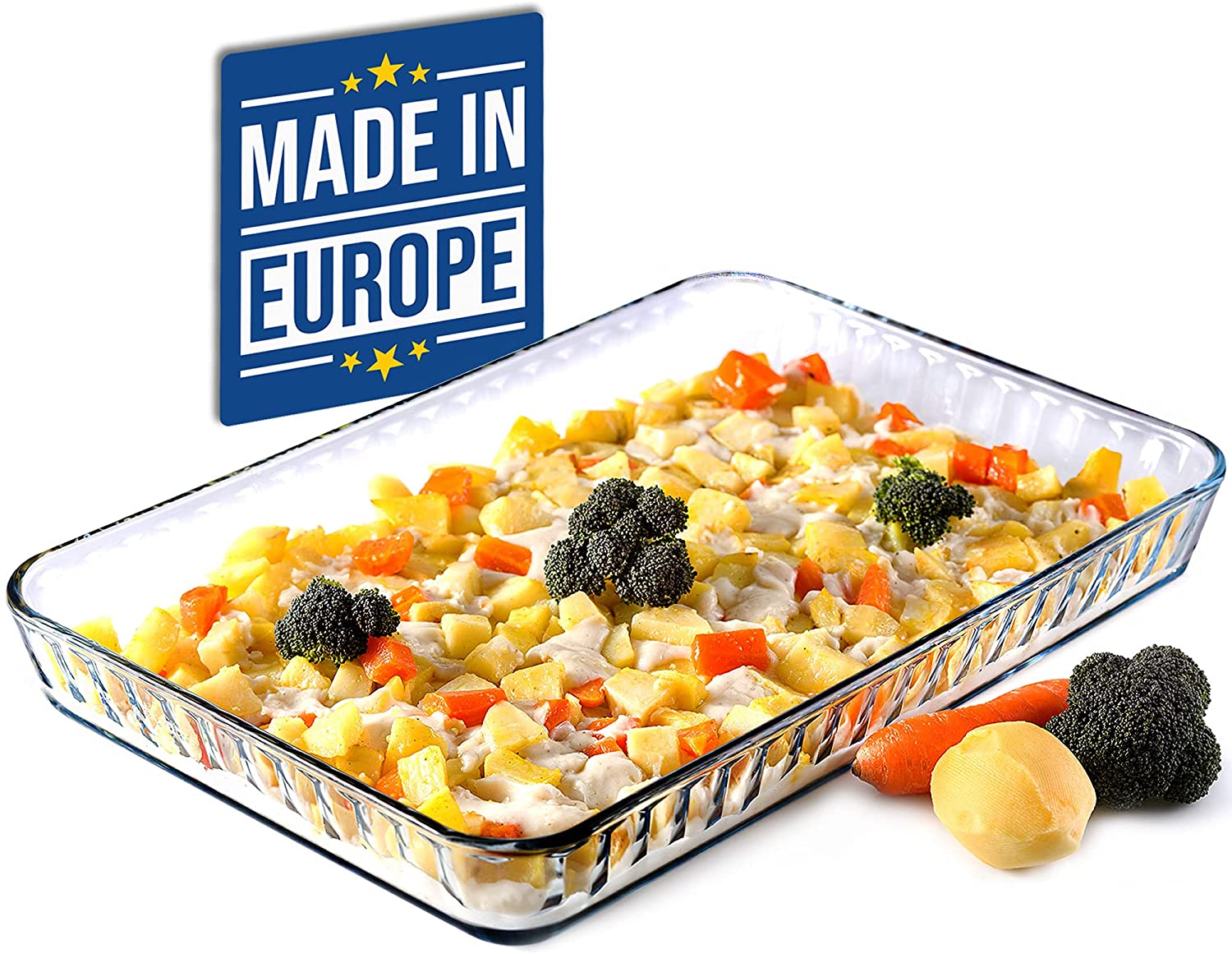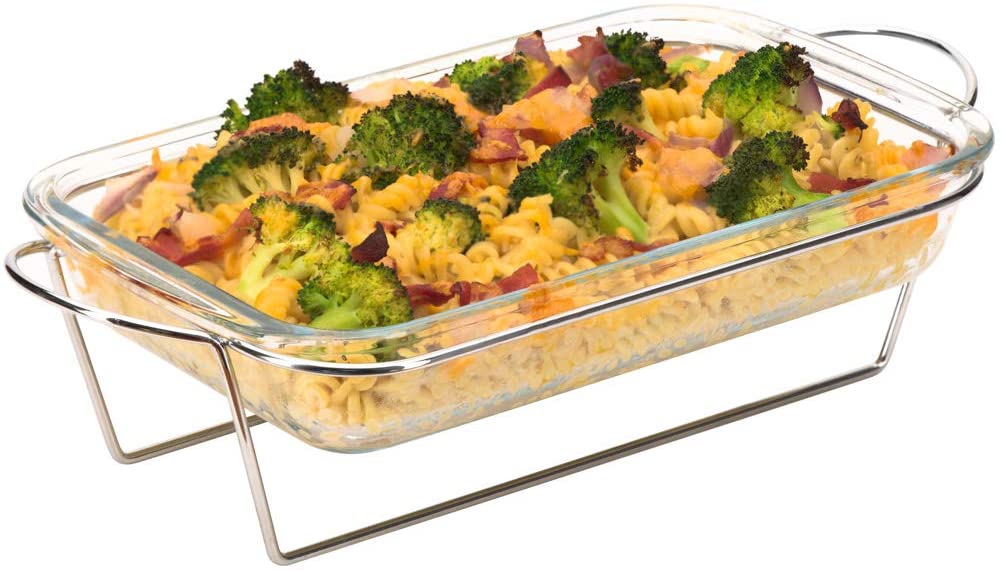Best Glass Baking Dish
Did you know that glass isn’t the best option to bake brownies? Or that even some of the best glass dishes shatter when moved from freezer to oven? Today, we will help you find the best glass baking dish and offer plenty of useful tips on how to choose glass bakeware.
Pros and Cons to Glass Baking Dishes
There are plenty of reasons why glass baking dishes are a good choice:
- Glass is chemical-free and contains no BPA due to the absence of plastic.
- It is recyclable and environmentally friendly.
- Glass baking dishes are safe to use with all foods, do not react with acidic foods such as tomatoes, and do not absorb liquids.
- Nothing leaches into your meals from glass.
- It’s simple to clean, and the majority may be thrown into the dishwasher.
- Glass does not absorb flavors or aromas from food.
- It’s a one-dish cooking method that may be stored in the refrigerator and reheated in the microwave. Some can be frozen.
Some drawbacks are:
- It has a low resistance to fracture.
- It is averse to rapid temperature changes, which can cause it to break.
- You have to leave the frozen dish on the counter until it reaches room temperature and can be reheated.
Is Glass Best for Baking Dishes?
While glass bakeware is heavier and takes longer to heat than metal, it holds heat for longer once heated. While baking something like a cake in a glass pan, you may notice that the sides and bottom brown considerably faster than the center cooks.
As a result, glass is ideal for foods you have to bake at moderate temperature for an extended period of time and then wish to keep warm once removed from the oven. This might be a casserole that you will transport from the oven to the table.
If you do need to bake a cake or another equally sweet dessert in a glass dish, many bakers recommend lowering the oven temperature by 25 degrees to avoid over-browning.
Keep in mind that glass is not good for strong heat and does not tolerate temperature shifts well. That is, you should not remove a glass pan from the refrigerator and immediately place it in a hot oven, since it may crack.
Types of Glass Baking Dishes
If you really want to cook proper meals and step up your culinary game, you have to choose the right types of glass baking dishes. There’s nothing really complicated about it, so just keep in mind what it is that you want to cook.
For Pies
Pies should always be made in round dishes. When it comes to baking a normal 9-inch pie, you may be startled to discover that some pie pans are labeled wrongly. Numerous pie pans advertised for 9-inch pans have a diameter of approximately 8 3/4 inches, and some are slightly larger.
Tempered glass is cost-effective, durable, and nonreactive. Additionally, because glass conducts heat faster than porcelain or stone, your butter will melt more quickly and form flaky layers without drowning the dough.
For Lasagna
Whenever you’re channeling your inner Garfield, you want the right bakeware to make delicious lasagna. A standard lasagna pan measures 9 by 13 inches and has a depth of between 2 and 3 inches.
Numerous chefs concur that lasagna should include a minimum of three layers of cheese, meat, and sauce. Naturally, if you opt for a deeper dish, you can make the lasagna even taller. Lasagna dishes are usually rectangular to fit the shape of the pasta.
For Casserole
With casserole dishes, the rules are much looser. You can choose between multiple shapes and sizes, based on the number of servings you want to make. For instance, a large dish that can hold three quarts can feed between four and six people.
For Brownies
I feel it’s really important to mention that if you bake brownies in a glass dish, it will be different than when you make it in a metal pan. Metal pans heat rapidly and consistently, whereas glass pans heat slowly but retain heat longer, frequently resulting in uneven bakes.
The exterior may be overdone, dry, and crusty when the interior has been thoroughly cooked. Using a specifically developed recipe for glass bakeware can help you overcome this issue.
Brownie pans are typically square (8 x 8 inches or 9 x 9 inches) or rectangular (9 x 13 inches), though circular cake pans and individual micro brownie pans are also available.
What to Look for in a Glass Baking Dish
Size
It’s critical to select the appropriate size glass baking dish for the number of servings you intend to make. If you’re looking for casseroles that accommodate approximately two quarts, choose 8 x 8-inch tiny square pans or 7 x 11-inch rectangular dishes.
When serving between three and six people, you’ll want a casserole that holds approximately three quarts, so large baking dishes measuring 9 x 13 inches will suffice.
Additionally, big circular casserole plates with a diameter of approximately 12 inches and a capacity of 3.7 quarts are available. Oval glass bowls are another choice; they can accommodate up to six meals.
Intended Use
Glass bakeware dishes are perfect for serving directly from the oven to the dinner table on a hot plate or trivet. Ensure that the carcass may be used on the stovetop for gravy whenever you want to bake or roast chicken in the oven.
If using a metal pan is not recommended for your stovetop, prepare your gravy in a metal skillet. Glass baking dishes are great for making pies, casseroles, cakes, pasta, or different roasted meats.
Glass Safety
Tempered glass is the safest material for a baking dish. Tempered glass is a type of soda-lime glass that has been heat-treated to increase its resistance to heat and overall durability.
Tempered glass is designed to shatter in a specific manner. If you’ve ever dropped a glass dish on a hard floor and it didn’t shatter, it was probably constructed of tempered glass.
Another type of tempered glass is considerably stronger and less susceptible to temperature changes: borosilicate.
Borosilicate tempered glass is composed of boric oxide, a substance that is extremely resistant to thermal shock, or rapid temperature changes, and chemical corrosion.
Freezer-Safe
While most quality glass baking dishes are freezer-safe, there are a few rules to keep in mind. When utilizing glass bakeware, extreme temperature swings should be avoided.
Never place extremely cold dishes in a hot oven, and vice versa. Sudden temperature variations might fracture or destroy the dishes. It’s always best if you allow a hot glass baking dish to cool down before putting it in the freezer.
Cleaning and Caring for Your Glass Baking Dishes
There are multiple ways for you to clean your glass baking dishes and I’m going to tell you about all of them.
- Baking Soda
If in doubt, reach for the baking soda.
- Using baking soda and a dab of dish soap, coat the bottom of your glass dish.
- Pour in hot water and let soak the entire mixture for approximately 15 minutes.
- After that, use a nylon or plastic sponge and scrub the spots away.
- As you scrape, add more baking powder. It has an abrasive texture that will aid in removing stubborn spots.
This is a product that does wonder for your glass bakeware:
- Soak your glass baking dish in hot water for about 15 minutes. This will loosen the stains.
- Throw away the water and use the Magic Eraser to scrape food stains.
Grab a dryer sheet and do the following:
- Fill your glass baking dish with hot water.
- Put a dryer sheet inside.
- Leave it soaking for about 15 minutes.
- The ingredients in the dryer sheet will soften the food stains. They should now be easy to remove with a sponge.
- Wash the dish with dish soap and warm water.
1. Editor’s Choice: Pyrex Basics Clear Glass Baking Dishes
When you’re looking to invest in some classic Pyrex dishes, this particular set might be the right choice for you. It comprises two baking dishes with a two and three-quart capacity.
The non-porous surface of the glass will be easier to clean because it doesn’t trap any food residue. Both of these dishes are advertised as being safe to use in the microwave and oven. You can also use the to store leftovers in the freezer and these are dishwasher-safe.
Pros:
- Dishwasher-safe.
- Oven and freezer-safe.
- Includes 2 sizes.
Cons:
- No lids included.
2. Runner Up: Luvan 3 Pack Glass Baking Dishes Set
The Luvan pack of three glass baking dishes is a product that not many people know about, so we wanted to give it a chance. It comes with two small dishes with a 12-ounce capacity each, and a large one that can hold up to 72 ounces.
They feature a wide rim that allows for an easy grip. The lights create an airtight seal and are made without any BPA. They also have a wide temperature tolerance, since they can sit at temperatures that vary from -4 to 1040°F.
Pros:
- High heat resistance.
- Airtight lid, leak-proof seal.
- Made with quality borosilicate glass.
Cons:
- Pictures are misleading; they are very small.
3. Customer’s Choice: FineDine Store Glass Casserole Dish Set
Let me show you another quality set that consists of four baking dishes suitable for microwave and oven use. Constructed of extremely tough, tempered glass, heat is spread evenly, preventing scorched spots.
The stackable dishes feature convenient handles that make them easy to transport and store. There is no need for grease because they are completely nonstick, making cleaning way easier. The slanted sides provide additional moving space, which simplifies meal service.
Pros:
- 4 convenient sizes.
- Stackable and easy to store.
- Freezer and microwave-safe.
Cons:
- Lids are not included.
4. Best for Small Batches: NUTRIUPS Store Mini Glass Baking Dish
NUTRIUPS oven glass pan is made of tempered glass and can endure temperatures ranging from 482° F to -40° F without succumbing to thermal shock. It can be transported directly from the freezer to the oven, making it an ideal dish for meal prep and carrying meals to occasions.
With these glass baking pans, you won’t have to worry about food, pathogens, odors, or any other noxious compounds seeping into them. It is one of the most hygienic pieces of kitchenware available.
This compact glass baking dish is ideal for baking small batches of cookies. Ideal for small casseroles with 1-2 servings.
Pros:
- 4 sizes to choose from.
- Oven and freezer-safe.
- Thermal shock resistance.
Cons:
- Very small for the price.
5. Best Basic: Amazon Basics Oven Safe Glass Baking Dish Set
The Amazon Basics bakeware, which is made of robust BPA-free borosilicate transparent glass, allows for easy monitoring while cooking from start to finish.
The glass dishes are oven, microwave, and freezer-safe and can resist temperatures of up to 1076°F and temperature changes without splitting.
Dishwasher safe, the nonporous glass will not absorb or retain food aromas, flavors, or stains. Handles with a textured surface are simple to hold with oven mitts.
Pros:
- High heat resistance.
- Dishwasher-safe.
- Includes 2 pieces.
Cons:
- Lids are a poor fit (for the lid version of the set).
6. Best High-Capacity: Volarium Store Glass Baking Dish
If you’re looking for a high-capacity glass baking dish, you have to check out this one from the Volarium Store. It can support temperatures of up to 300°C and as low as -40°C.
Made of borosilicate glass, this dish is one of the most hygienic types of kitchenware available. They are very scratch resistant and retain their sanitary and transparent features throughout their service life when you follow the usage and cleaning directions.
Pros:
- High capacity fish.
- Dishwasher-safe.
- Stackable design.
Cons:
- Doesn’t have handles.
7. Best for Freshness: Anchor Hocking Glass Baking Dish
Hocking Anchor TrueFit Glass bakeware items include a flexible, easy-open lid that maintains freshness while allowing for convenient storage. The TrueFit lids are BPA-free and dishwasher safe on the top rack. Lids are simple to open and include a transparent glass for easy viewing.
The Anchor Hocking Glasses are suitable for use in electric and gas ovens up to 425 degrees Fahrenheit and are dishwasher-safe for easy cleanup.
Pros:
- BPA-free construction.
- Oven and freezer-safe.
- Dishwasher-safe.
Cons:
- Lid doesn’t close properly.
8. Honorable Mention: Moss & Stone Glass Dish
This has to be one of the best products in today’s list. Not only do you get a quality glass baking dish, but it also comes with a support to prevent it from coming in direct contact with the table.
It’s made with borosilicate glass and is oven, freezer, and dishwasher-safe. The wide edges will serve as handles to make it easier to pick up the dish even when it’s hot. It can withstand temperatures as high as 400°F.
Pros:
- Dishwasher-safe.
- Table stand included.
- Versatile use.
Cons:
- Complaints about shipping mishandling.
FAQ
What kind of glass is used for baking?
Borosilicate glass, tempered glass, and Pyrex glass are used to make baking dishware. Pyrex is a trademark type of glass made with borosilicate which is less likely to break when exposed to temperature changes.
Can you bake all types of glass?
You can only bake with glass dishes that are marked as being heat-resistant and can sustain the thermal shock.
How can you tell if the glass is oven-safe?
The maximum temperature should always be marked on the label of the product.
In Conclusion
The best glass baking dish is something you choose only when you know what you need it for. Depending on what you’re going to cook, you have to choose specific sizes and shapes, with a depth that’s suitable for your dishes.
Photo credit: FotoHelin/Shutterstock

